Imagine that a small monster will live in a home aquarium, today it’s easy: you don’t need to go far to Mexico for a valuable inhabitant - this prospect is attractive to many aquarists. Axolotl is called a fantastic animal, and its appearance, in fact, corresponds to such a characteristic. In fact, this is the neotenic larva of the salamander (the creature becomes sexually mature without turning into an adult form).
This creature is of considerable interest to scientists, since it is characterized by the regeneration of the tail, legs and gills. Because so many axolotls live in captivity: fortunately, this does not become an obstacle to their reproduction.
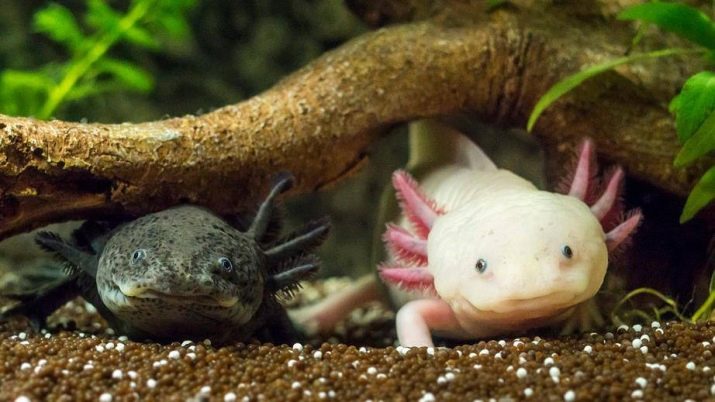
Conditions for keeping
In wildlife, the larva of an ambistoma lives exclusively in Mexico, its neotenic form is axolotl. They can live in captivity for about 10 years. At home, it is not so easy to keep a water monster in an aquarium, it is a rather demanding underwater inhabitant.
If the larva is young and small, then it will fit in a small aquarium of 50 l, but adults will no longer be able to fully exist in such cramped conditions. The minimum tank volume for one or two of these monsters is 100 liters.
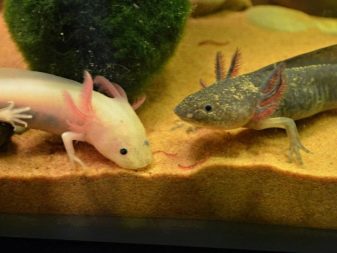
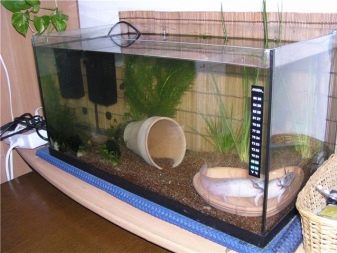
Water
For aquarium owners, the problem is sometimes that this pretty salamander is a cold-loving marine creature. The temperature parameters of the water should not be higher than +20 degrees Celsius. If she rose to +24 and above, this is a real threat to the axolotl, which will lead to its ailments and subsequent death. The higher the temperature, the less oxygen in the water. because the warmer the water in the tank, the more significant the aeration for axolotl life. If for some reason you cannot keep a creature in cold water, give up the idea of acquiring it.
Little dragons (also called axolotls) can exist only in pure water. Therefore, the reservoir must be constantly cleaned, not forgetting to change the water. Filtration of water in the tank will be different from that applied to aquarium fish. Monsters love the slow flow, because the powerful filter that forms the flow of water is considered aggressive for axolotls.
A good choice would be an internal filter with a washcloth: it is moderately strong, but does not form a powerful current. And at a cost it is also quite acceptable.
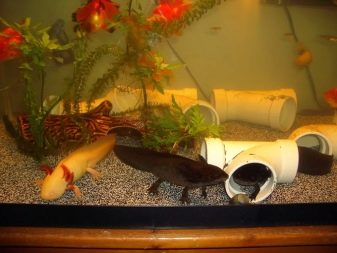

Priming
The bottom of the tank must be lined with clean sand at least 3 cm thick. On such a bottom, it will be convenient for the dragon to rearrange its paws. Shells and small pebbles in the axolotl house are unacceptable - the animal often swallows them, which makes them sick and even dies. The pebbles that you will use to form shelters must be such that the salamander cannot swallow it.
The monster is active at night, so there should be no shortage of dark nooks and crannies in the aquarium, where during the day the animals would hide from intrusive light. This can be a slide with large pebbles or a coconut shell, or even a clay pot with a hole so that the axolotl can hide in a pot - these are common options for such shelters.
Be sure to plant vegetation in the container, on the leaves axolotl will find shelter for eggs. Live algae is usually replaced by beautiful artificial plants.
Any objects that are in the tank do not imply sharp angles - otherwise the salamander may cut itself, its body is very tender. Of the plants, sagittaria, naias, cladophore, ludwig are preferred.
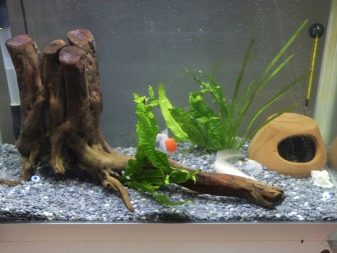
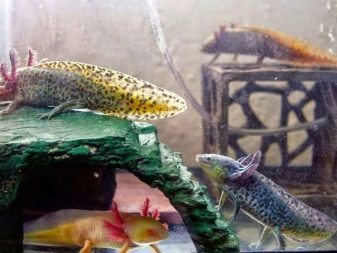
Lighting
The type and brightness of this parameter is not important for a water monster, because dragons, you can say, have poor eyesight. They are considered nocturnal animals who like to be active in the dark.
Food
The sexually mature salamander and its fry are fed differently. The only common thing is that axolotls are predators, there are teeth in their oral cavity. And predators, as we know from school biology lessons, require protein for development. In the natural environment, water monsters enjoy treating themselves with infusoria, crustaceans and zooplankton - protein, indeed, is the basis of their diet.
In the aquarium, axolotl is fed:
- bloodworms and earthworms;
- tadpoles, cyclops, daphnia, artemia;
- slugs and snails;
- very small fish;
- purchased food for predatory fish.
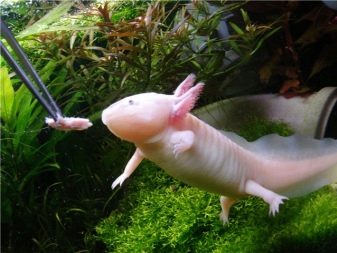
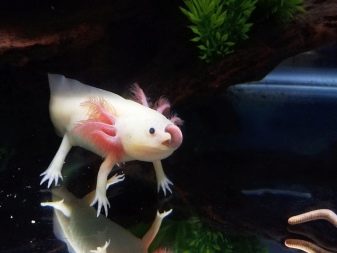
But it is impossible to feed axolotl with the meat of mammals, the body of the salamander will not absorb such food. The animal is unpretentious in food, eats every two days. Moreover, the process of digesting food in sea dragons is so slow that if you leave axolotl without food for two or three weeks, it will most likely survive. But still do not conduct harsh experiments, but do not feed more than once every two days.
The fry eat microworms very well, they will not refuse mosquito larvae. If you use pellets of food for predator fish, soak them in water. When the monsters grow up, you can add mussel and shrimp meat to their diet, give them fish fillets. But try not to feed live fish to axolotl, alas, they are often carriers of diseases.
Even if you find information on aquarists on aquariums who feed axolotl for veal and low-fat beef, you should not take such a dubious example from them. With such food, the gastrointestinal tract of amphibians copes with great difficulty.
Remove food debris from the aquarium immediately, because monsters prefer to live in a clean reservoir.
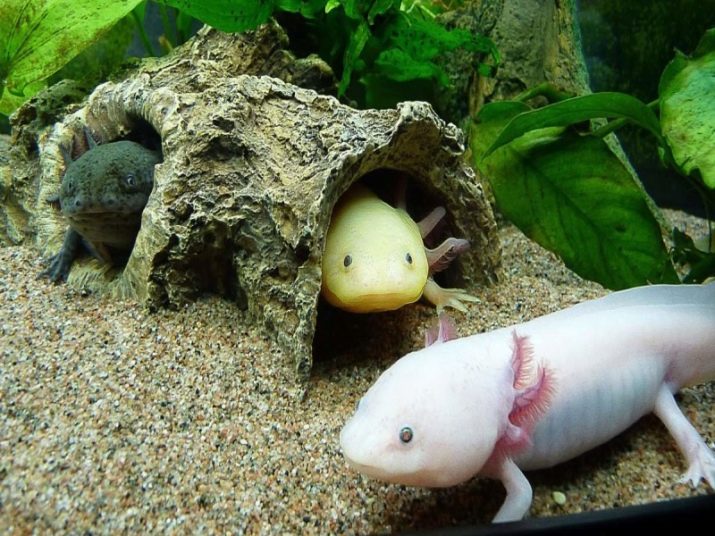
How to care?
Sea monster care points can be concentrated in one detailed memo.
- Experts calculated the volume of an ideal aquarium for one axolotl - 76 liters. It must be filled with water not exceeding +20 degrees Celsius.Water is prepared in the same way as liquid for freshwater fish. If you ignore the preparation, chlorine and other aqueous chemicals can seriously damage amphibians. The aquarium cover should be kept closed, since theoretically the salamanders can escape.
- Next is the installation of an external canister filter.. This is done to maintain the water in a clean state, since the axolotli simply will not accept another liquid. Organize a monster with a slow flow of water, fast will become a great stress for amphibians.
- Provide a competent substrate to the underwater kingdom of axolotl. Large aquarium pebbles, fine sand are quite suitable. Care does not include the use of small granules or coarse sand so that the animal does not swallow them.
- You should dim the light in the aquarium, since both the usual axolotl and albino do not need the lighting that the fish are used to. You need to turn on the lamp less often, since the heat emanating from it can harm amphibians.
- Check your pet’s health regularly. If you live in a region with a hot climate, adjust the temperature in the room in which the aquarium stands. Avoid temperature increase, if the water heats up to +23 degrees and above, the salamander expects a heat stroke.
- Feed your pet the right food. Any live food is excluded, mammalian meat is excluded. Do not overfeed axolotl, an adult is more than enough to feed three times a week. He needs to be given as much food as he can eat in half an hour.
- Once a week, try to pour at least half of all the water out of the aquariumto replace it with fresh.
- Keep amphibian safe, do not allow adults and fry in one tank. Other underwater inhabitants in the aquarium with axolotl are also useless.
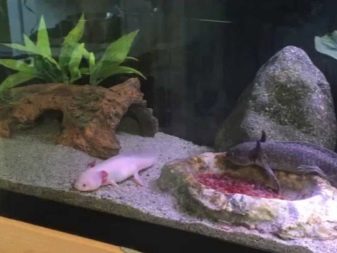
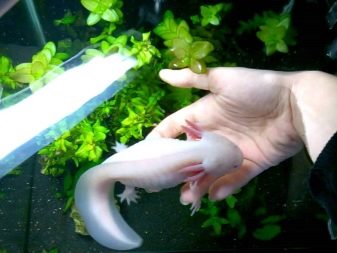
Finally, do not touch it, even if you really want to stroke the little dragon. This is a fragile creature, if necessary, it can be caught with a net. From contact with people, the salamander experiences severe stress, and besides, she can easily bite her breadwinner.
What kind of fish can I keep with?
Salamander larvae are preferably kept in a separate container, all of which should be the same size. Fish and snails will not get along with the monster, as he prefers to eat his neighbors without any sentiment. But large fish, which are too tough for axolotl, will also not be good neighbors of amphibians - because of its bright color, he himself may become a victim. For some reason, fish are decided to attack the gills of the axolotl. If the damage is minor, the body regenerates it. But major injuries become irreversible for the salamander.
And in general, the neighbors, other than their own kind, do not need axolotl.
And there are several serious reasons for this:
- amphibians lead a nocturnal lifestyle, and by their predatory nature they will certainly attack peacefully sleeping fish;
- the temperature of the water in which sea dragons live does not suit most types of aquarium fish;
- adult salamander should not be kept in the same tank with fry, as cannibalism is inherent in these animals.
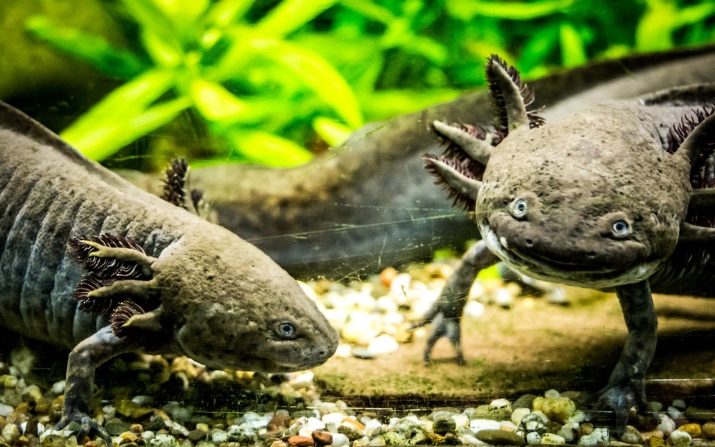
Adults, in fact, can attack fry, especially if they lack protein food.
But you can hear that the friendly nature of the neighborhood is revealed by axolotl with catfish, ancistrus and adult zebrafish. The monster does not make friendship with other aquarium fish. If you decide to make friends with axolotl with shrimp, he will like such friends, but they will not, very quickly he will turn new neighbors into his own treat.
Do not even think of combining axolotl and spur frogs or turtles in one territory. Water turtles are predators, because the dragon will be killed by them as soon as possible. Frogs also will not lag behind the amphibian, they will chase after it in the hope of biting off a piece of the gill, for example. Triton is also not the best companion for the dragon.
Conclusion: the best neighbors are axolotls of equal age.Just don’t starve them, otherwise the dragon’s friendship will end, they will begin to bite each other, attack a relative, and someone will eventually win.

Possible difficulties
The main and obvious difficulty is not to allow the temperature indicators in the aquarium to increase in summer. But to reduce the degree in the axolotl’s house, it is enough to throw a cube or two of ice into the aquarium.
It is worth saying about the bite of amphibians. As they do not tell aquarists not to touch the salamander with their hands, they still try to contact her. And the animal can bite. In most cases, this is not harmful to humans, rather, the axolotl itself will be stressed by such contact. But an allergic reaction is not excluded, and then you have to take an antihistamine. In addition, getting an amphibian out of the water can cause it not only psychological, but also quite a physical trauma - this is a very fragile animal.
Amphibians can get sick. Common diagnoses for axolotl include anorexia, ascites, hypovitaminosis, and intestinal obstruction. But if the care is right, the conditions are suitable, and the salamander does not get sick, she will live in an aquarium up to 15 years. As a rule, for so long a monster is not nameless, aquarists come up with a nickname for it. Of the common names of axes, peeped at the forums, the following can be noted: Lottie, Axon, Phoebe, Prosh, Dormidont and Kuzma.
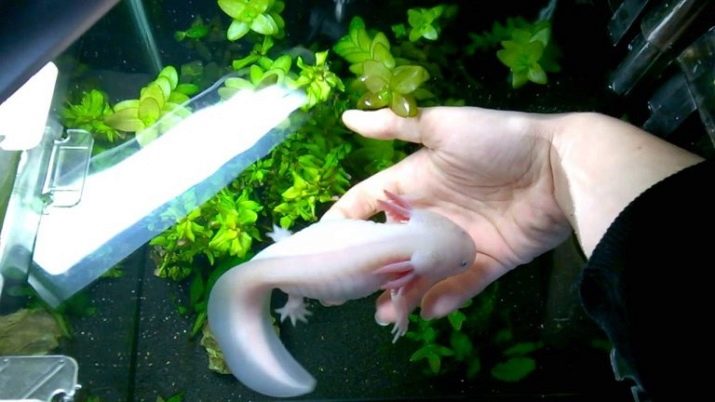
About the features of the content of axolotl, see the next video.










